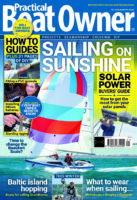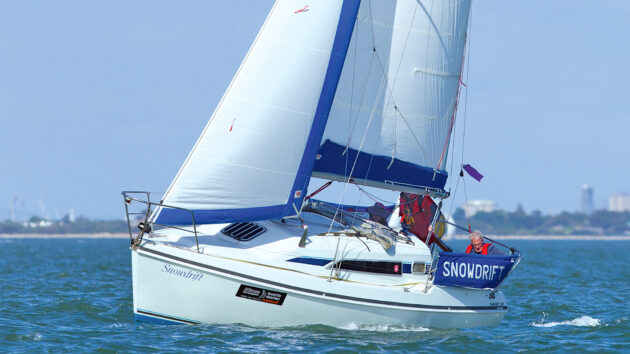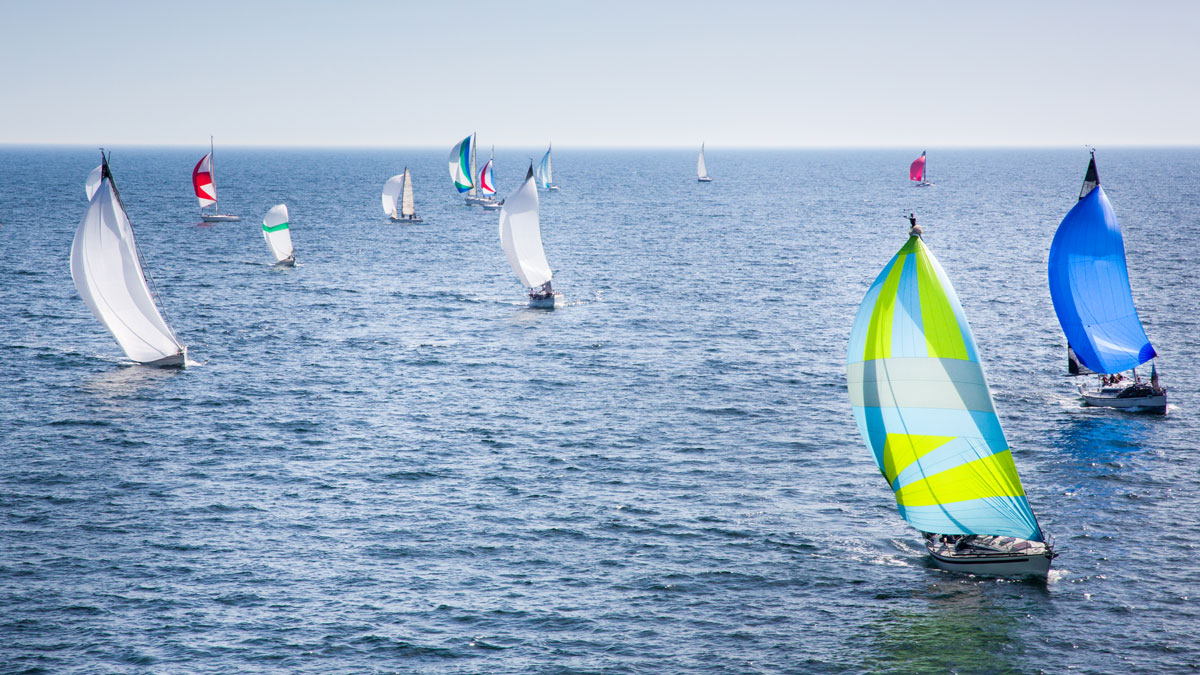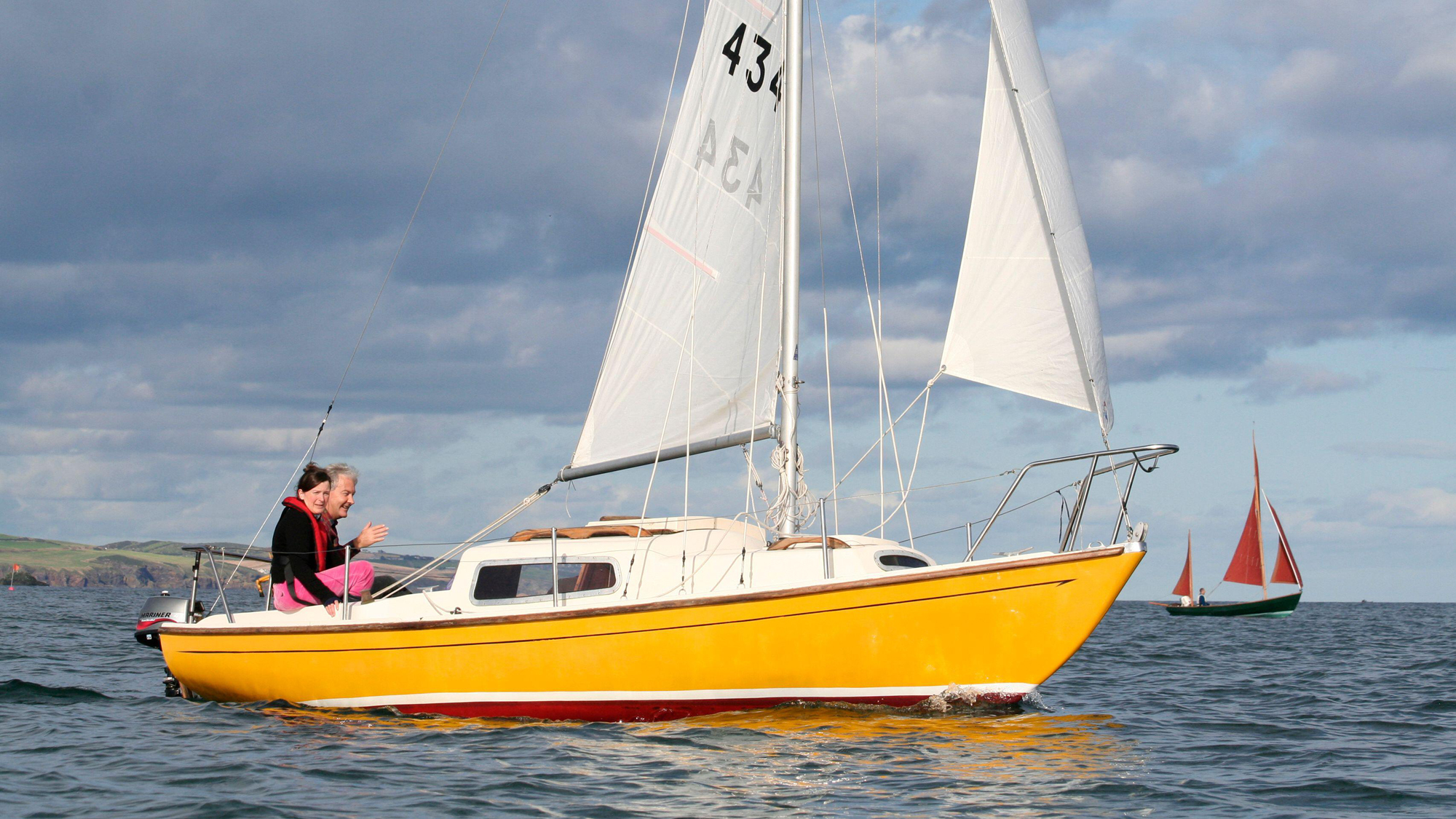Rupert Holmes spotlights the Hunter Ranger 265, one of the most desirable smalls cruisers of the 90s, plus a selection of alternative 27 foot boat designs. Beneteau First 260 Spirit | MG Spring 25 | Parker 27 | Legend 27 | Jeanneau Sun 2500.
From the mid-1980s onwards, Hunter Boats in Essex produced a succession of popular and comfortable 26 to 27 foot boat designs that sail well and offer modern, bright and spacious accommodation.
Key selling points included a separate double owner’s cabin aft and a heads compartment at the foot of the companionway, where it is easily reached from the cockpit and is close to the boat’s centre of motion. Easily-handled rigs, with self-tacking jibs and single-line mainsail reefing added to the appeal.
Yet, Hunter Boats had its roots firmly in the racing sector, and these were still designs with good performance, even in twin keel format.
The first of these was the Horizon 26, which was based on the existing Delta 25 hull but with an all-new coachroof giving standing headroom and considerably more interior volume. It was an instant hit in the 25 to 27 foot boat market and won the Best Production Boat of the Year award.
This was followed by the Horizon 273, based on the same hull, but with an elongated transom that helped improve performance and reduce pitching in a head sea.
However, the Ranger 265 heralded a completely different era thanks to a new David Thomas-designed hull created expressly for a well-mannered and surprisingly spacious cruiser. It offered a lot more stability, together with more interior space thanks to the wide beam that is carried further aft.
There is accommodation for four adults, plus two child berths forward in a semi-open plan layout that includes a double aft quarter cabin.
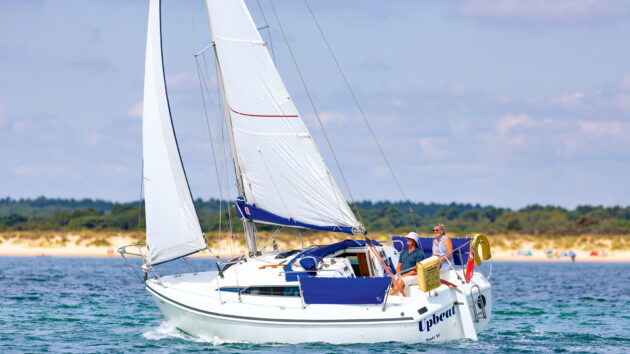
With twin keel weight carried low, plus a wide beam aft, the Ranger 265 is very stable. Photo: David Harding.
Today, chines above the waterline aft are commonplace, but they were very unusual back in the mid-1990s, and Thomas was one of the first designers to employ them, though those of the Ranger 265 are somewhat rounded.
They serve several purposes, including increasing form stability as the boat heels, while keeping wetted surface area low to boost performance in light airs. They also help to markedly reduce rolling when sailing downwind in strong winds and awkward sea states.
In addition, the chined hull increases accommodation volumes aft and allows for a wider cockpit with more space for crew, which helps to confer the feel of a larger boat. Yet at the same time, the Ranger 265 is small enough to be able to brace yourself comfortably in place when sitting on the windward side.
A 27 foot boat with offshore capabilities
The best twin keel boats can sail upward just as efficiently as a fin keel model. Most Ranger 265s were the twin keel versions that were marketed as ‘twin fins’ thanks to their efficient shape with a low centre of gravity and relatively deep draught.
This version also has a remarkably high angle of vanishing stability of 147°, one of several factors that make this 27 foot boat a proper offshore yacht, despite its modest overall length.
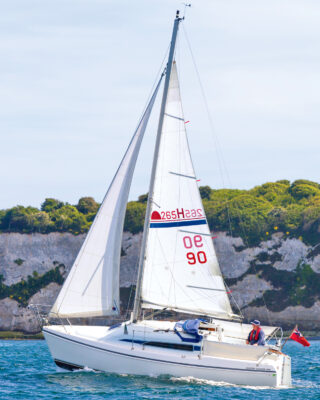
The 265’s long waterline and broad transom maximises internal volume. Photo: David Harding.
Two engine options were offered: an outboard mounted in a well aft was a more economical choice when the boat was new; however, this is a less ergonomic arrangement than an inboard motor, and most examples were fitted with a 9hp single-cylinder Yanmar 1GM diesel. An increasing number have since been re-engined with a larger twin-cylinder 14hp Beta model.
Almost 100 examples are believed to have been built between 1994 and 1999, when the Ranger 265 morphed into the Hunter Channel 27, of which a further 29 were built. In effect, this was a mark two version based on the same hull design, but with a modified deck moulding.
I sailed one of the first to leave the factory on a blustery day in which gusts in the showers hit more than 30 knots. Even though this was a twin keel example, with the sail plan deep reefed, the boat performed admirably without excessive heel or weather helm in the gusts.
The same hull was also used for the Hunter Pilot 27, which has a deck saloon-style coachroof with a sheltered steering position. This proved to be a relatively popular model, with more than 100 examples built over a 10-year period starting in 1996.
Hunter Ranger 265 specifications
LOA: 8.05m/26ft 5in
LWL: 6.81m/22ft 4in
Beam: 2.80m/9ft 2in
Draught: (fin keel) 1.54m/5ft 0in ; (twin keel) 1.05m/3ft 5in
Displacement: (fin) 2,538kg/5,600lb ; (twin) 2,590kg/5,700lb
Ballast: 960kg/2,120lb
Mainsail: 18.95m2/204ft2
Self-tacking jib: 9.33m2/100ft2
Owner association: hunterassociation.org.uk
27 foot boat designs to rival the Hunter Ranger 265
By the mid-1990s, new 27 foot boats had become expensive compared to vessels of more than 30ft. The underlying reason for this lies in the increasing industrialisation of boatbuilding, meaning the costs of building a 32ft and a 27 foot boat became surprisingly similar. Both require the same amount of labour to fit wiring, plumbing, rigging, deck gear and so on. Equally, they have the same number of spars, sails, engines, and cookers.
As a result, with a few notable exceptions, 27 foot boats tended to be increasingly niche designs. Today many make excellent choices, with good sailing qualities and manageable mooring fees, along with accommodation that’s more ergonomic and just as spacious as many older designs that are four or five feet longer.
It’s also worth noting that many marinas and mooring providers offer discounted rates for boats of less than 8m in length, especially if a deep-draught berth is not required.
Importantly, vessels of this size are also typically significantly less expensive to maintain than a larger boat, given that sails are smaller and standing rigging is cheaper to replace. At the same time many tasks, from stripping antifoul to polishing topsides, are also quicker and easier.
Beneteau First 260 Spirit
Also launched in 1994, this Groupe Finot design is an exact contemporary of the Ranger 265 and was part of a larger range of sporty, yet comfortable 21-30ft cruiser-racers that remain popular on the second-hand market. It’s a twin rudder design with a pivoting lifting keel engineered to allow the boat to dry out in a sheltered location at low water, supported by the rudders.
At a time when British boatbuilders were agonising about increasing competition from continental rivals with sophisticated accommodation layouts, it’s perhaps ironic that for the 260 Spirit, Beneteau reverted to a more traditional layout that has a smaller feel than that of the Ranger 265.
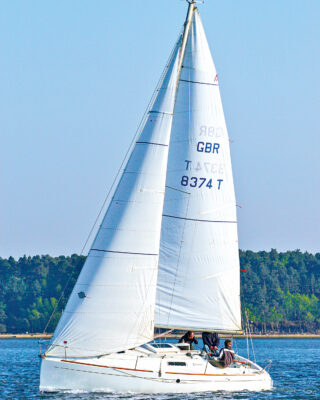
The Beneteau First 260 Spirit has a well-protected cockpit. Photo: David Harding.
The forepeak houses a double vee-berth and is separated from the saloon by a full-width toilet compartment. There is space for a folding table in the saloon, which also houses the worm drive mechanism for raising the keel.
The port side of the companionway has a small galley, and there’s an aft-facing chart table on the other side that can double as additional galley worktop space if necessary. Maximum headroom of 1.75m (5ft 9in) will be marginal for some, although there are a couple of inches more at the foot of the companionway, under the sliding hatch.
While the lack of a quarter cabin aft reduces accommodation space, it also means there was no temptation to compromise the cockpit layout by raising the floor. It’s therefore a deeper cockpit than is usual for a design of this era, with a more secure feel and the benefit of a pair of deep cockpit lockers.
In 2004, this model morphed into the Beneteau First 25.7, retaining the same hull as the 260 Spirit, but a new deck moulding increased headroom, while the interior also benefited from a higher standard of fit-out in a more up-to-date style.
In addition, this version was also offered with a fixed fin keel with 1.45m (4ft 9in) draught that simplifies handling and maintenance at the expense of shoal draught capabilities. This model, in turn, was later re-badged as the First 25.7S and then the First 25S.
In all, around 1,000 examples using the original Finot-designed hull were built over a decade and a half, though sales are believed to have declined markedly in later years.
Beneteau First 260 Spirit specifications
LOA: 7.49m/24ft 7in
LWL: 7.35m/24ft 1in
Beam: 2.76m/9ft 1in
Draught: 0.85-1.85m/2ft 9in-6ft 0in ; (fin keel First 25.7) 1.45m/4ft 9in
Displacement: 2,300kg/5,070lb
Mainsail area: 19.2m2/210ft2
Headsail area: 17.0m2/180ft2
MG Spring 25
Although an earlier model, dating from 1986, this Tony Castro design was widely considered to be way ahead of its time.
It also gained celebrity status as the game-changing new design intended to reverse the declining fortunes of the Mermaid boat yard in the 1980s television series Howard’s Way set on the River Hamble in Hampshire.
The wing keel was a key design element and one for which there was plenty of hope and hype in the mid-1980s; this was only a couple of years, remember, after the wing-keeled Australia ll made history in wresting the America’s Cup from American hands for the first time in 150 years.
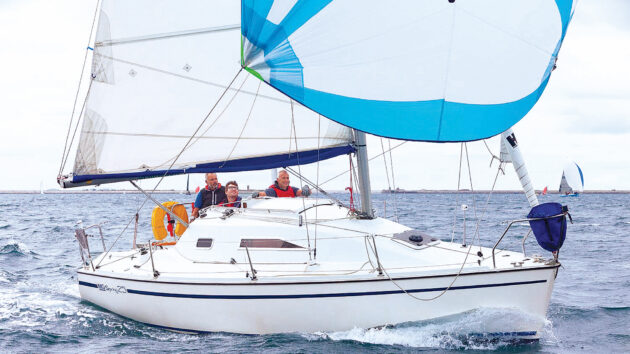
The MG Spring 25’s winged keel and a tall fractional rig which provides plenty of sail make for good all-round performance.
For the MG Spring 25, the keel combined many of the advantages of a conventional fin, including good sailing ability close-hauled, with the advantages of shallow draught, as the delta-shaped base of the keel is large enough to support the boat if it dries out over low water.
On the downside, however, it represents a large increase in wetted surface area that saps performance in light airs.
Nevertheless, this was seen as being a quick design at the time and, like the Hunter Ranger 265, one that would look after her crew in stronger winds.
A further advantage of wing keels is a tendency to stabilise the boat’s motion, creating the feel and comfort of a larger vessel when at sea. In addition the Spring 25’s twin rudders – also a novelty at the time – markedly improved control when driving hard downwind or reaching in stronger conditions.
Below decks, the boat has a similar semi-open plan layout to the Hunter, with a double quarter cabin to port and heads compartment next to the companionway to starboard. Immediately ahead of these are an L-shape galley to port and a small forward-facing chart table that makes an ideal desk area when working from home on board.
The saloon is pushed further forward and therefore narrows towards the bow, but still has two long settees with enough space to seat five to six people around a central table. This area is open plan to the bow, where the seat backs fold to create a full-length double vee-berth, making six berths in total, though it’s important to recognise there would be very little stowage with this number of people on board.
Parker 27
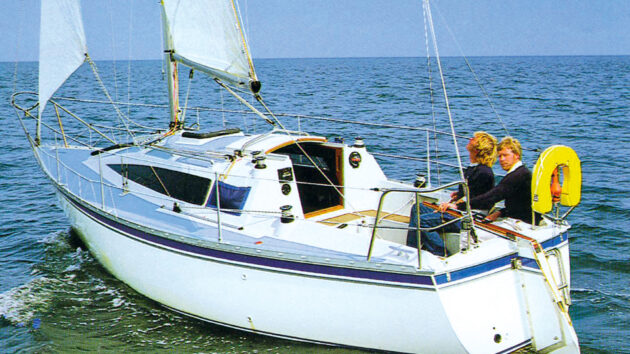
The Parker 27 is equally happy on the racing circuit as it is cruising.
This fast, lifting keel model was a development of the concept behind the Ron Holland-designed Super Seal 26, which was built by John Baker near Exeter.
This 27 foot boat design combined quick performance with shallow draught and surprisingly civilised accommodation for its era. Bill Parker took over production in the early 1980s, moving it to Boston and then creating the Parker 27 in 1987.
The Parker 27 represents a significant improvement on the original Super Seal 26 design in a number of respects. Greater freeboard, for example, markedly improved the rather marginal 1.72m (5ft 8in) offered by the Seal 26 and extended the overall length to 27ft.
Parker also made the vertically lifting keel 300kg heavier, though most of the ballast is placed internally in the bilge. Nevertheless, the outcome is a very desirable 27 foot boat and a small cruiser that’s also suitable for club racing.
The accommodation lacks a separate quarter cabin aft, but as with the Seal models, unusually for a 27 foot boat, the separate forecabin includes a standing changing area at the head of the berth on the port side of the box for the lifting keel, with the toilet compartment on the starboard side.
The later Parker 275, introduced in 1990, represented a further big upgrade, and a new hull moulding was built for this model. In addition, more ballast was transferred to the lifting keel, which now weighed around 350kg (700lb), with the weight concentrated low down.
There were also further improvements to the interior, including a double quarter berth aft.
Production of the original Seal 26 started in 1981, with roughly 110 boats built, while 29 Parker 275s were completed, plus 14 Parker 275s. The latter was replaced by the Parker 285 in 1998.
Parker 27 specifications
LOA: 8.23m/27ft 0in
LWL: 7.31m/24ft 0in
Beam: 2.82m/9ft 3in
Draught: 0.38m-1.6m/1ft 3in-4ft 3in
Displacement: 2.800kg/6,160lb
Ballast: 1.135kg/2,500lb
Sail area: 37.7m2/406ft2
Sailing association: parkerseal.org.uk
Legend 27: an all- American 27 foot boat
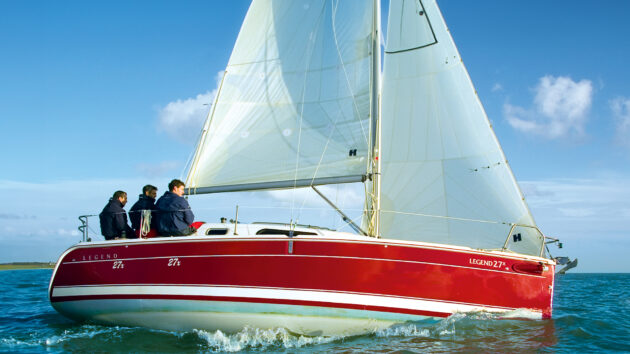
The sportier Legend 27X came with a fin keel, tiller steering, a taller rig and retractable bowsprit. Photo: Rupert Holmes.
This American design is the third generation of 27 foot boats created by Luhrs Corporation in Florida and is a later 2004 design that was aimed at a fairly conservative market.
It offers good space both in the cockpit and below decks with a largely open plan layout. This offers up to six berths, but provision for stowage is limited.
Instead, the builders took the attitude that this boat is most likely to be used for weekending, with items largely remaining inside kit bags. Equally, much of the space that might be available for galley stowage is given over to housing a large portable 12V cool box, allowing produce to be bought from home and kept cool on the journey to the boat.
In place of the double aft quarter cabin typically found on most British designs in this selection, the Legend features a transverse berth across the full width of the boat under the cockpit, located in a cabin accessible next to the galley. This berth is a generous 2m (6ft 6in) long and 1.35m (4ft 6in) wide, while the separate heads compartment opposite the galley is also a good size for a 27 foot boat.
The saloon features a pair of 1.95m (7ft) long settees on each side of a central table with one folding leaf. Right forward you’ll find a second double berth, the head of which folds out over the ends of the settees. Headroom is a maximum of 1.8m (6ft), with a commendable 1.77m (5ft 11in) in the galley and heads. At the front of the saloon, this figure tapers down to 1.65m (5ft 6in).
This model was also offered in a sportier format as the Legend 27X, still a 27 foot boat but with a taller rig and retractable bowsprit for flying larger asymmetric spinnakers.
It also has a more efficient 1.6m (5ft 3in) draught fin keel in place of the shallow fin or twin keels of the standard boat, plus upgraded deck gear, and the wheel steering of the standard model was replaced with a tiller.
I tested the 27X when it was first launched, finding it to be light on the helm and well balanced, but it was a heavy boat compared to other performance designs and didn’t sell as well as the cruising model.
Legend 27 specifications
LOA: 8.33m/27ft 4in
Hull length: 8.23m/27ft 0in
Beam: 3.0m/9ft 11in
Draught: (twin keels) 1.05m/3ft 5in ; (standard fin keel) 1.52m/5ft 0in
Displacement: 3,400kg/7,500lb
Ballast: 1,540kg/3,400lb
Jeanneau Sun 2500: a not-quite 27 foot boat for weekenders
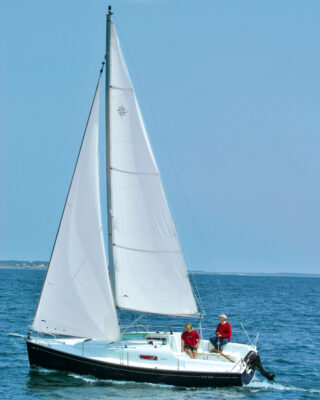
The 265’s long waterline and broad transom maximises internal volume. Photo: David Harding.
This is a later and lighter design from 2001 that doesn’t offer the rugged offshore capabilities of the Hunter Ranger 265 or the sophisticated interior.
But it represents an interesting choice for those seeking an easily maintained and more up-to-date boat for local use, including weekend cruising and occasional longer jaunts, but who don’t intend to go offshore or need the capability to handle stronger winds.
Below decks, there’s a good galley and heads compartment near the foot of the companionway, plus a double quarter berth aft on the port side. The saloon is further forward than most and tapers towards the forepeak.
The Sun 2500 was available in two versions, one with an inboard engine and the other with a transom-mounted outboard motor, both designed to dry out occasionally on the swing keel and twin rudders. It’s lightly ballasted compared to some of the designs in this selection, which limits this model to more coastal use in sensible weather.
I also sailed the smaller Jeanneau Sun 2000 when it was first launched, finding it to be fun to sail and a particularly appealing boat for glorious summer days with light or moderate winds. It also has a surprisingly large amount of volume below decks for such a small boat, though the open plan interior fit out is a lot more basic than that of the Sun 2500.
Jeanneau Sun 2500 specifications
LOA: 7.50m/24ft 7in
LWL: 7.15m/23ft 5in
Beam: 2.90m/9ft 6in
Draught: 0.69m-1.75m/2ft 3in-5ft 8in
Displacement: 2,699kg/5,950lb
Ballast: 672kg/1,482lb
Rupert Holmes has sailed 85,000 miles in more than 250 different boats. He won the 2022 Sevenstar non-stop round Britain and Ireland race and is currently preparing for the Globe 40 double-handed round the world race.
Why you should race your cruising boat
Ben Meakins finds out why – and how – PBO readers from around the UK go racing in their cruising
Corribee Mk2 vs Silhouette Mk3: which is the best pocket cruiser?
In his latest used boat review, Clive Marsh compares two of the best small sailboats for sale. The Silhouette Mk3…
Seascape 24 vs Seascape 27: Is a planing cruiser really practical?
Bowling effortessly downwind at 15 knots can be fun, but what are the compromises? David Harding sails the Seascape 24…
Bay Cruiser 26: space, pace and practicality
How do you combine trailability, performance and live- aboard comfort in a 26-footer? David Harding explains the secrets of the…
Want to read more articles like this?

A subscription to Practical Boat Owner magazine costs around 40% less than the cover price.
Print and digital editions are available through Magazines Direct – where you can also find the latest deals.
PBO is packed with information to help you get the most from boat ownership – whether sail or power.
-
-
-
- Take your DIY skills to the next level with trusted advice on boat maintenance and repairs
- Impartial, in-depth gear reviews
- Practical cruising tips for making the most of your time afloat
-
-
Follow us on Facebook, Instagram, TikTok and Twitter

